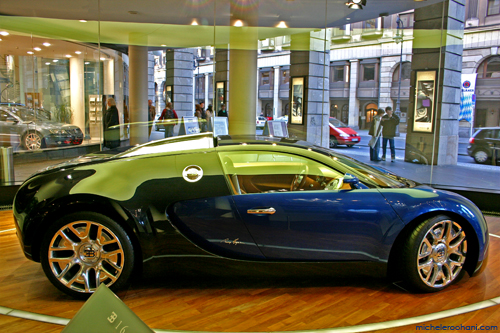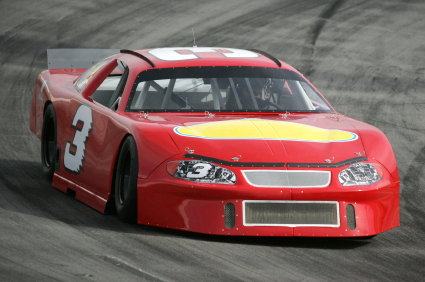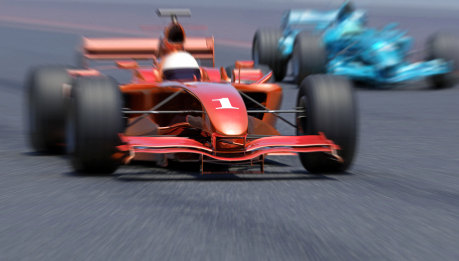The Bugatti Veyron is the most expensive car in the world and it is street legal. The price varies between $1,200,000 to $1,500,000 (by the time I finish this post the falling dollar will make this European made car even more expensive). With a maximum speed of more than 400 km per hour, the Veyron is unmatched in the super sports category and offers a total of 1,001 hp; it is the fastest accelerating car reaching 0-60 in 2.5 seconds.
I took the above picture in Berlin a couple of years ago (the only one in this post I actually took) and decided to do some “soft” research about the subject to share with friends who can be as clueless about this as I am – try not to roll your eyes every time I am stating the obvious. Fasten your seat belts and get ready for testosterone galore:
Stock Car: a souped up version of a factory car that is only allowed to reach top speeds of approximately 187 mph (301 km/h) – the most prominent championship in stock car racing is the NASCAR championship. The 700 horsepower engines of these cars have been altered from their original factory design.
Daytona 500 is one of the most watched events on American television and the most important race in the NASCAR series – it is a 200-lap, 500 mile (805 km) race held annually in Daytona Beach, Florida. Even I have heard of Dale Earnhardt (both father and son)…
Formula One car: a single-seat, open cockpit, open wheel race car with substantial front and rear wings and engine positioned behind the driver. It’s made out of composites of carbon fiber, light but extremely strong. By regulation the cars use rear wheel drive and can handle 900 horsepower (in comparison my car has around 250 hp). The top speed of these cars is around 230 mph (370 km/h).
Formula One race, is the highest class of open wheeled auto racing . The “formula” in the name is a set of rules which all participants and cars must meet. The F1 world championship season consists of a series of races, known as Grands Prix. The big name in this category is Michael Schumacher and his Ferrari. The Indy Racing League is essentially the American version of F1.
Pit Stop: “in motorsports, a pit stop is where a racing vehicle stops in the pits during a race for refuelling, new tires, repairs, mechanical adjustments, a driver change, or any combination of the above” but what is interesting and not so obvious to the non-initiated, is that pit stop work is carried out by up to twenty mechanics (pit crew) and that pit strategy is one of the most important features of the race.
So, this wasn’t that bad, was it? The next step for me would be to actually watch a car race on tv and witness the thunder of roaring engines beating their chests…




take a look at Cite de l’automobile http://en.wikipedia.org/wiki/Mus%C3%A9e_National_de_l'Automobile_de_Mulhouse. Schlumpf Collection- Mulhouse. In their collections you can fine a Bugatti Royale which should be worth over ten millions.
F1 appears to be a very simple sport but it’s so intricate because everyone spends billions just to be a millisecond faster.
Schumacher used to be king. He’s retired now which has made the sport substantially more interesting-better competition.
Nice post!
Dear Michele, the Bugatti became a symbol of fate remembering Isadora Duncan killed by her shawl in Nice 1927 in a Bugatti. Remember Vanessa Redgrave in the film about the San Francisco born Duncan. She was the temptress of Sergei Yessenin, the great Russian peasant poet, who committed suicide in 1926. The two children of Duncan were killed in a car accident. The secretary of Yessenin killed herself at the graveside of her lover. Those were the days.
Maybe because of my age, or maybe because of my wage, I still like streetcars, horse-pullen carriages and bicycles.
Askin Ozcan
Author of “WISDOM IN SMILE” and “SMALL MIRACLES” and other books.
I love your title: Fast car for Dummies – if there ever was a better double entendre on the subject! ; )
Especially in the US, where the speed limit is 55-65mph, our fascination with fast cars is an exercise in futility. Let’s see, I’ll spend a million bucks so I can accelerate to 55 faster than you! These cars should come with a bounty hunter in the trunk since you’re buying it with the intent of breaking the law! But why do we preoccupy ourselves with these objects of admiration? Ask an enthusiast and he/she will surely respond: it’s a celebration of human engineering. Ask why is their celebration limited to automobiles, and not to rockets, dams, bridges, capacitors and refrigerators, and they will have a hard time answering. Beyond the typical B.S. we feed ourselves to legitimize most of our irrational behavior may reside our instinctual need for self conceptualization. We want to stand out in the crowd. Put a group of middle schoolers in uniforms and there’s bound to be a few who will insist on adding a pin to their lapel or wear a weird hat. Our need to be cool is essentially our need to be unique. The man who parks his Bugatti curb-side on Rodeo Drive is simply marketing his capitalistic uniqueness and sending the rest of us the subliminal message that: Yes, I have the largest pocket on the block! Yes, I am important! Yes, I am successful! And finally, yes, I not only have the money, but I’m also exciting – an often gross exaggeration! Shortly after the invention of the wheel, some Joe Schmo Canaanite decided to polish his wheel to make it shinier! That was the first step towards the Buggati’s and the Lamborghinis of the world and the notion of an apex predator and the alpha male. We all need something to preoccupy our meandering mind every morning we awaken to the world. So we fill our heads with the grandiose notions of a 1001 horse power car that costs a million bucks and can send our heads for a tail spin. Such car’s owner is telling us: “Yes I can!” To which I reply: When is the car with 1002 horse power going to come out? : )
“This is great piece in conveying the basics of auto racing, in the cute way for “Dummies”. With this diversification, you are bound to reach a wider audience.
It so happens that I am a car enthusiast. I know about cars, watch and sometimes participate in the racing events. It is a largely unknown fact that NASCAR attracts the largest number of spectators of any sport in the US/world. I do not suggest it to everyone, however, a one-time participation is promised to be an unforgettable experience. I saw a race 2 years ago which drew over 230,000 fans. The tickets were sold out by September for the April race. The roar of the engines, the enthusiasm of the crowd, the sophistication of communication and racing strategies, the side events and the tail gating that goes on for the whole week, the fact that hotels rooms become scarce within the radius of 150 miles and the 100 mile traffic snarl that rivals freeway 405 in the rush hour are sure to make it an unforgettable experience!
While Ali has a few valid points he is missing the most important factor-the thrill of going fast (or as some call it the “need for speed”). It is true that it is not for everyone and unless you have the “fever” you can not appreciate it, and my limited penmanship I surely can not convey the adrenaline rush, fast blood pumping heart, and the feeling of being alive (may be not for long!) when doing 150 miles in an open roadster on a sunny spring day. Yes, there could be consequences in being caught, but a) they have to be able to catch you first and b) one can not live life in fear. So live it up!”
Jennifer, don’t get me wrong, I for one definitely appreciate the need for speed. In fact, I have a stack of old speeding tickets to prove it! 🙁 So, I don’t want to sound didactic here and I do agree with you; but the need for speed, which you describe in your post is different. I’m sure the feeling you describe is there whether one’s driving a VW GTI at 120 mph or a Buggati at 300 mph! Beyond a certain speed, the certainty of death upon crash is irrelevant to the actual speed! I also don’t know how fun the speed is, when one is taking off of a runway on a commercial plane. But you brought up a very interesting point: the need for speed and its effects on the body. What’s interesting is that the very symptoms you described, “the fast adrenaline rush, fast blood pumping heart, and the feeling of being alive” are also the pharmacological side effects of an amphetamine called speed! So, you’re right, my post, which was mainly dealing with the social aspects of the car and driver totally missed this point. Let’s face it, the need for speed is no different than the need for a fix; it’s a form of addiction! I mean, if one gets high from it, and if this high is a physiological effect caused by it, and if one chases this high over and over again…. well, it sounds like speed, just like the drug speed, is addictive!
Wow… we might be up to something here! Can we envision a world where you’re approached by a junky in a dark alley, willing to do anything in return for a fast lap around the block?!!! Maybe that’s why we have a speed limit… it’s not because of a correlation between accidents and speed; but to prevent us from becoming hooked on velocity! Now I see… that’s what the government has been up to! 🙂 Maybe it’s like the blood alcohol limit… we can drink up to .08% and drive up to 65mph, anything beyond will surely turn us into alcoholics and speed junkies!!! 🙂
I know NASCAR is big in the States… but we just love to flock to whatever we’re told is “IN” right now… it gives us a chance to have water cooler conversations and feel on top of it … NASCAR is big now, like Golf was earlier, and Basketball, and Tennis before that, and baseball before those, all the way to the time when a bored cave man kicked a pebble all the way back to his cave and invented Stoneball! It’s been suggested that Stoneball caused more head and toe injuries on free kicks and corner kicks that any sport since. And this poor tribe played Stoneball happily until they were all consumed by neighboring cannibals who could not resist their enlarged calf muscles as a result of this sport!
Ok, time to speed out of this long entry! 🙂
Awesome post.